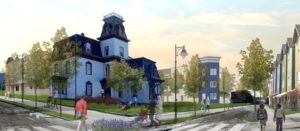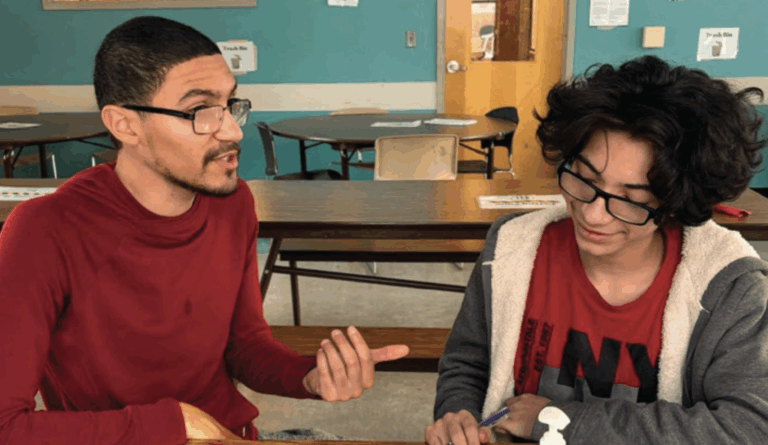$30 million federal investment is cause for celebration, but in many ways the work has just begun. The video below offers a virtual tour of the new housing options that will be made possible with the HUD CHOICE funding.
In May, news was celebrated in Lewiston and across Maine that the city would receive a $30 million CHOICE Neighborhood Implementation Grant from the federal Department of Housing and Urban Development. This historic investment comes after years of work by the city, local organizations, and neighborhood leaders and residents to develop and begin to execute a comprehensive plan to transform the Tree Streets Neighborhood into a place where all residents can thrive.
The John T. Gorman Foundation has been privileged to have a role in this process, providing grants and technical assistance to assist local partners in their work. And, like all the stakeholders involved, we know that while the HUD CHOICE grant may be the catalyst to fundamentally improve life in the Tree Streets, there is much work still to be done. This article offers an overview of the impact this funding will have and where assistance is still needed.
Housing, People, and Neighborhood
Home to hundreds of families who have immigrated to Maine over the last 20 years, the Tree Streets Neighborhood is one of the most diverse areas in the state and is alive with families and children. However, decades of disinvestment, lack of opportunity, and unsafe housing have led to persistent poverty and the highest rate of childhood lead poisoning in the state. When Lewiston received a CHOICE Planning Grant in 2018, hundreds of neighborhood residents shared their thoughts and ideas on what would make the Tree Streets Neighborhood a healthier and more prosperous place to live. From these conversations came the Growing Our Tree Streets Plan, which has nine goals covering all aspects of well-being in the neighborhood.
Knowing a HUD CHOICE Implementation Grant would not be able to cover the entire plan, Lewiston Economic Development Manager (and John T. Gorman Fellow) Misty Parker said partners picked elements for its application that were most urgent. Those elements fell into three areas – housing, people, and neighborhood.
Most of the grant funding – $21 million – will go toward housing, replacing 92 units in poor condition at the HUD assisted Maple Knoll Apartments with 185 new, attractive, and energy-efficient rental units. One development will be across from Kennedy Park, a mix of 71 one- and two-bedroom apartments close enough to walk to jobs in the downtown. Another 74 units – many large enough to accommodate families – will be spread out over 10 buildings in another part of the neighborhood. A third site will have 40 apartments. Owned and managed by Lewiston Housing Authority, half of the total units will be a mix of workforce and market rate housing – the other half is set aside for Maple Knoll residents.
The renderings below offer a view of what these new housing options will look like in the neighborhood.
Safer housing is just one element of the CHOICE Grant for those 92 households, however. “We have a people plan all about how we support them not just in their moves, but in their lives in general,” Parker said. Community Concepts Inc. is heading the “people” portion of the plan, which matches each household with a mobility mentor who will help them navigate housing options and connect to other supports. The mentors are trained in the EmPath framework of self-sustainability, which emphasizes family stability, well-being, financial management, education and training, and employment and career management.
To assist in this support, many resources in the community are being strengthened, including the Strengthen L-A job training and matching program, mentoring for youth, and healthcare navigators – which will benefit everyone in the neighborhood who could use these services.
“While the grant is very targeted on these housing residents, we are using the opportunity to do things to benefit the entire community,” Parker said. These include a number of neighborhood infrastructure improvements funded by the grant:
- Expansion of the B Street Health Clinic, making dental and behavioral health services easier to access;
- A community food center to provide food at affordable prices, while providing space to food entrepreneurs and job-training opportunities; and
- Expansion of the Promise Early Education Center, which will allow for two new Head Start classrooms, creating much-needed childcare capacity.
The City of Lewiston has also committed $1.5 million in Community Development Block Grant funding over the next five years to improve sidewalks, lighting, parks and more.
More Work to Be Done
While the federal investment is significant, it does not cover everything that is needed. For the Foundation’s part, it continues to invest in child care access, workforce development, support for youth, and other areas of the Transformation Plan. But Parker said the hope is that the federal grant will spur investment from new sources to improve services and opportunity.
Chris Kilmurry, Executive Director of Lewiston Housing Authority, echoes those sentiments. “What we’re doing will only really scratch the surface of what the needs are,” he said. “What we’re really hoping is that this begins an avalanche of smart, appropriate investment that won’t spur gentrification but will spur opportunity for people living here and for those who want to come to Lewiston and be a part of the community.”
Stakeholders noted another valuable resource that will be needed in the years ahead – feedback from the community. Two local advocates, Ashley Medina and Craig Saddlemire, both praised the neighborhood-driven process that went into the plan’s development and cited the need for continued engagement to ensure it moves forward in the community’s best interests. Both are active with Healthy Neighborhoods, a coalition of local organizations and residents that laid the groundwork and community momentum for the Transformation Plan.
“What I like about the whole process is that it listened to the people in the community – the people who live here were the ones making decisions, sharing thoughts and ideas,” said Medina. “That’s important because if this community is going to change, we want to hear what people here want to see.”
The HUD Grant is cause for celebration and an incredible validation of the neighborhood’s potential. But in many ways, it’s just the beginning. The John T. Gorman Foundation is privileged to continue being a part of it.









